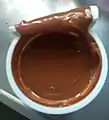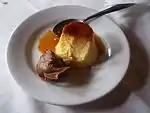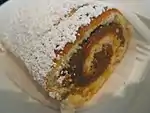 | |
| Alternative names | caramelized milk, milk candy, milk jam |
|---|---|
| Type | Confectionery |
| Region or state | Latin America |
| Main ingredients | Milk, sugar |
Dulce de leche (Spanish: [ˈdulse ðe ˈletʃe, ˈdulθe ðe ˈletʃe]), caramelized milk, milk candy or milk jam is a confection popular in Latin America, prepared by slowly heating sugar and milk over a period of several hours. The resulting substance, which takes on a spreadable, sauce-like consistency, derives its rich flavour and colour from non-enzymatic browning.[1][2] It is typically used to top or fill other sweet foods.
Names and similar confections
Spanish dulce de leche and Portuguese doce de leite mean "sweet [made] of milk". Other names in Spanish include manjar ("delicacy"), arequipe and leche quemada ("burnt milk", a term popular in Mexico); also in Mexico and some Central American countries dulce de leche made with goat's milk is called 'cajeta'.[lower-alpha 1][3] In the Philippines, dulce de leche made with carabao milk is called dulce gatas,[4] and is a specialty of Negros Occidental province.[5]
In French it is called confiture de lait (milk jam). In France, it is popular in the region of Normandy and Savoy, where it is commonly served with fromage blanc or crêpes.[6]
The same confectionery is also known as kajmak in Polish cuisine, named after Turkish kaymak, a kind of clotted cream. In Poland, it is most commonly used for wafers or the mazurek pie traditionally eaten on Easter.[7]
Preparation
| Nutritional value per 100 g (3.5 oz) | |
|---|---|
| Energy | 1,320 kJ (320 kcal) |
55.4 g | |
| Sugars | 49.7 g 4.92 g |
7.35 g | |
| Saturated | 4.53 g |
| Monounsaturated | 2.14 g |
6.84 g | |
| Vitamins | Quantity %DV† |
| Vitamin C | 3% 2.6 mg |
| Minerals | Quantity %DV† |
| Calcium | 25% 251 mg |
| Sodium | 9% 129 mg |
| Other constituents | Quantity |
| Water | 28.7 g |
| Cholesterol | 29 mg |
| |
| †Percentages are roughly approximated using US recommendations for adults. | |
The most basic recipe calls for slowly simmering milk and sugar, stirring almost constantly until the sugar dissolves (baking soda then can be added), after more constant stirring (between 1.5 – 2 hours) until the mixture thickens and finally turns a rich brown golden-brown colour.[9]
Another method calls for letting a gallon of milk stand in room temperature for an entire 24 hours. The gases will spoil the milk and what is left is curd and whey. This is then boiled, causing the solids to flow to the top. The solids are removed and sugar is added. This mixture is stirred until it becomes hard, after which it is removed from the heat and left to cool. After it cools, it is broken up for consumption. Out of a gallon, this method yields about two cups.
Other ingredients such as vanilla may be added for flavor. Much of the water in the milk evaporates and the mix thickens; the resulting dulce de leche is usually about a sixth of the volume of the milk used. The transformation that occurs in preparation is caused by a combination of two common non-enzymatic browning reactions called caramelization and the Maillard reaction.[1][2]
Another method of preparation, similar to Russian boiled condensed milk known as "varyonaya sgushchyonka", involves using canned or boxed sweetened condensed milk and cooking it in a pressure cooker for 20 to 25 minutes for a light color and slightly soft consistency, or 40 to 45 minutes for a darker color and firmer consistency. If using condensed milk from a box, it should be wrapped in about 5 to 6 layers of aluminum foil to prevent it from bursting.[10][11]
It is also possible to place the condensed milk in a glass jar and boil it in the pressure cooker. In this method, different ingredients can also be added to the sweetened condensed milk, such as shredded coconut or peanuts. However, certain precautions need to be taken, such as wrapping the jar with a kitchen towel and lining the pressure cooker with another kitchen towel so that the bottom of the jar does not touch the cooker (as contact may cause the glass to shatter). The cooking time is similar to the previous method (around 35 to 40 minutes).[12][13] Water should be added to the pressure cooker – enough to cover the cans, boxes, or jars of condensed milk. A small amount of vinegar can be added to the water in the pressure cooker to prevent it from becoming discolored at the bottom. In all cases, once ready, it is important to let the dulce de leche cool completely, which takes about 2 hours.[10][12]
Use
Dulce de leche can be eaten alone, but is more commonly used as a topping or filling for other sweet foods, such as cakes, churros, cookies (see alfajor), waffles, flan cakes (aka crème caramel (known as pudim in Portuguese-speaking ones) (not to be confused with British pie-like variant of flan), fruits like bananas and candied figs, and ice creams; it is also a popular spread on crepes (panqueques), obleas (wafers), and toast.
Gallery
 Dulce de leche pot
Dulce de leche pot
 Crème caramel, a variant of a flan cake
Crème caramel, a variant of a flan cake

 Dulce de leche roll
Dulce de leche roll
See also
- Baked milk – beverage derived from milk
- Banoffee pie – English dessert pie
- Basundi – Indian sweet
- Brunost – Norwegian cheese
- Caramel – confectionery product made by heating sugars
- Caramel candy – confectionery product made by heating sugars
- Crème caramel – custard dessert with soft caramel on top
- Condensed milk – milk from which water has been removed and sugar added
- Custard – semi-solid cooked mixture of milk and egg
- Krówki – Polish confectionery
- Manjar blanco – term used in Spanish-speaking area of the world in reference to milk-based delicacies
- Penuche – candy
- Russian candy – sweet toffee-like dessert
- Ryazhenka – fermented dairy beverage
- Sandesh – Bengali confectionery
- Teja
- Tres leches cake – dessert
Notes
References
- 1 2 McSweeney, Paul L. H.; Fox, Patrick F. (20 April 2009). Advanced Dairy Chemistry: Volume 3: Lactose, Water, Salts and Minor Constituents. Springer Science & Business Media. ISBN 978-0-387-84865-5.
- 1 2 McGee, Harold (2004). On Food and Cooking: The Science and Lore of the Kitchen. New York: Scribner. p. 657. ISBN 0-684-80001-2. Retrieved 8 August 2012.
- ↑ "Origen mítico del dulce de leche" [The Mythical Origin of Dulce de Leche] (in Spanish). Clarín. 6 April 2003. Retrieved 8 June 2014.
- ↑ "Desilusión: el dulce de leche no fue un invento argentino" [Disappointment: dulce de leche was not an Argentine invention]. El Cronista (in Spanish). 23 September 2016. Retrieved 8 January 2024.
- ↑ Tajanlangit, Eli F.J. (3 February 2012). "They're stealing our dulce gatas". The Visayan Daily Star. Retrieved 8 January 2024.
- ↑ Group, Octopus Publishing (2001). Larousse Gastronomique. Octopus Publishing Group. ISBN 978-0-600-60688-8.
- ↑ "Polish Chocolate and Dulce de Leche Mazurek". Polish Your Kitchen. 9 April 2017. Retrieved 27 February 2021.
- ↑ "FoodData Central".
- ↑ "Dulce de Leche". Food Network UK. Retrieved 28 October 2022.
- 1 2 "Doce de leite na pressão". Panelinha (in Brazilian Portuguese). Retrieved 8 June 2023.
- ↑ "Receita com apenas 2 ingredientes: doce de leite de panela de pressão". Receitas (in Brazilian Portuguese). Retrieved 8 June 2023.
- 1 2 "Doce de leite em pote "Dulce de leche in a jar"".
- ↑ "Homemade dulce de leche with coconut and peanut paçoca" - DOCE DE LEITE ARTESANAL COM COCO,E PAÇOQUITA, retrieved 8 June 2023

